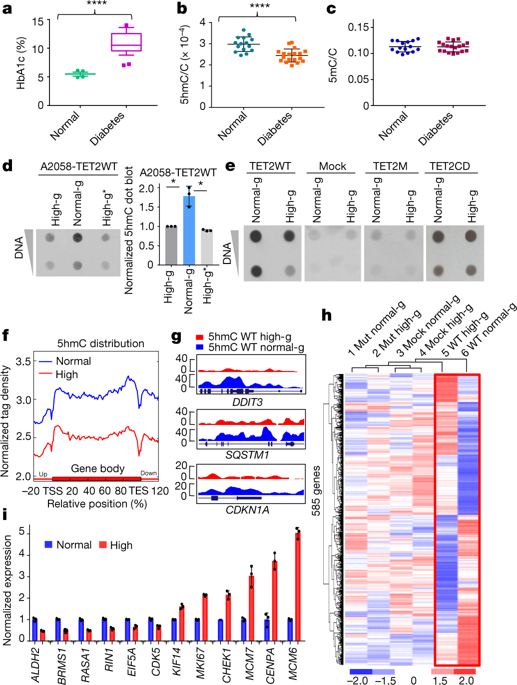Our official English website, www.x-mol.net, welcomes your
feedback! (Note: you will need to create a separate account there.)
Glucose-regulated phosphorylation of TET2 by AMPK reveals a pathway linking diabetes to cancer
Nature ( IF 50.5 ) Pub Date : 2018-07-01 , DOI: 10.1038/s41586-018-0350-5 Di Wu 1, 2 , Di Hu 1, 2 , Hao Chen 1, 3 , Guoming Shi 1, 2 , Irfete S Fetahu 2 , Feizhen Wu 1, 2 , Kimberlie Rabidou 2 , Rui Fang 2 , Li Tan 1 , Shuyun Xu 4 , Hang Liu 1 , Christian Argueta 2 , Lei Zhang 5 , Fei Mao 6 , Guoquan Yan 5 , Jiajia Chen 5 , Zhaoru Dong 1 , Ruitu Lv 1 , Yufei Xu 2 , Mei Wang 2 , Yong Ye 1 , Shike Zhang 2 , Danielle Duquette 2 , Songmei Geng 4 , Clark Yin 2 , Christine Guo Lian 4 , George F Murphy 4 , Gail K Adler 2 , Rajesh Garg 2 , Lydia Lynch 2 , Pengyuan Yang 5 , Yiming Li 6 , Fei Lan 1 , Jia Fan 1 , Yang Shi 1, 3 , Yujiang Geno Shi 1, 2
Nature ( IF 50.5 ) Pub Date : 2018-07-01 , DOI: 10.1038/s41586-018-0350-5 Di Wu 1, 2 , Di Hu 1, 2 , Hao Chen 1, 3 , Guoming Shi 1, 2 , Irfete S Fetahu 2 , Feizhen Wu 1, 2 , Kimberlie Rabidou 2 , Rui Fang 2 , Li Tan 1 , Shuyun Xu 4 , Hang Liu 1 , Christian Argueta 2 , Lei Zhang 5 , Fei Mao 6 , Guoquan Yan 5 , Jiajia Chen 5 , Zhaoru Dong 1 , Ruitu Lv 1 , Yufei Xu 2 , Mei Wang 2 , Yong Ye 1 , Shike Zhang 2 , Danielle Duquette 2 , Songmei Geng 4 , Clark Yin 2 , Christine Guo Lian 4 , George F Murphy 4 , Gail K Adler 2 , Rajesh Garg 2 , Lydia Lynch 2 , Pengyuan Yang 5 , Yiming Li 6 , Fei Lan 1 , Jia Fan 1 , Yang Shi 1, 3 , Yujiang Geno Shi 1, 2
Affiliation

|
Diabetes is a complex metabolic syndrome that is characterized by prolonged high blood glucose levels and frequently associated with life-threatening complications1,2. Epidemiological studies have suggested that diabetes is also linked to an increased risk of cancer3–5. High glucose levels may be a prevailing factor that contributes to the link between diabetes and cancer, but little is known about the molecular basis of this link and how the high glucose state may drive genetic and/or epigenetic alterations that result in a cancer phenotype. Here we show that hyperglycaemic conditions have an adverse effect on the DNA 5-hydroxymethylome. We identify the tumour suppressor TET2 as a substrate of the AMP-activated kinase (AMPK), which phosphorylates TET2 at serine 99, thereby stabilizing the tumour suppressor. Increased glucose levels impede AMPK-mediated phosphorylation at serine 99, which results in the destabilization of TET2 followed by dysregulation of both 5-hydroxymethylcytosine (5hmC) and the tumour suppressive function of TET2 in vitro and in vivo. Treatment with the anti-diabetic drug metformin protects AMPK-mediated phosphorylation of serine 99, thereby increasing TET2 stability and 5hmC levels. These findings define a novel ‘phospho-switch’ that regulates TET2 stability and a regulatory pathway that links glucose and AMPK to TET2 and 5hmC, which connects diabetes to cancer. Our data also unravel an epigenetic pathway by which metformin mediates tumour suppression. Thus, this study presents a new model for how a pernicious environment can directly reprogram the epigenome towards an oncogenic state, offering a potential strategy for cancer prevention and treatment.Modulation of DNA 5-hydroxymethylcytosine by glucose reveals an AMPK–TET2–5hmC axis that links diabetes to cancer.
中文翻译:

AMPK对TET2的葡萄糖调节磷酸化揭示了将糖尿病与癌症联系起来的途径
糖尿病是一种复杂的代谢综合征,其特点是长时间的高血糖水平,并经常与危及生命的并发症有关 1,2。流行病学研究表明,糖尿病也与癌症风险增加有关 3-5。高血糖水平可能是导致糖尿病和癌症之间联系的主要因素,但人们对这种联系的分子基础以及高血糖状态如何驱动导致癌症表型的遗传和/或表观遗传改变知之甚少。在这里,我们表明高血糖症对 DNA 5-羟甲基组有不利影响。我们将肿瘤抑制基因 TET2 鉴定为 AMP 活化激酶 (AMPK) 的底物,AMPK 在丝氨酸 99 处磷酸化 TET2,从而稳定肿瘤抑制基因。葡萄糖水平升高会阻碍 AMPK 介导的 99 位丝氨酸磷酸化,从而导致 TET2 不稳定,继而导致 5-羟甲基胞嘧啶 (5hmC) 和 TET2 在体外和体内的肿瘤抑制功能失调。用抗糖尿病药物二甲双胍治疗可保护 AMPK 介导的丝氨酸 99 磷酸化,从而提高 TET2 稳定性和 5hmC 水平。这些发现定义了一种调节 TET2 稳定性的新型“磷酸化开关”,以及将葡萄糖和 AMPK 与 TET2 和 5hmC 联系起来的调节途径,从而将糖尿病与癌症联系起来。我们的数据还揭示了二甲双胍介导肿瘤抑制的表观遗传途径。因此,这项研究提出了一个新模型,说明有害环境如何直接将表观基因组重新编程为致癌状态,
更新日期:2018-07-01
中文翻译:

AMPK对TET2的葡萄糖调节磷酸化揭示了将糖尿病与癌症联系起来的途径
糖尿病是一种复杂的代谢综合征,其特点是长时间的高血糖水平,并经常与危及生命的并发症有关 1,2。流行病学研究表明,糖尿病也与癌症风险增加有关 3-5。高血糖水平可能是导致糖尿病和癌症之间联系的主要因素,但人们对这种联系的分子基础以及高血糖状态如何驱动导致癌症表型的遗传和/或表观遗传改变知之甚少。在这里,我们表明高血糖症对 DNA 5-羟甲基组有不利影响。我们将肿瘤抑制基因 TET2 鉴定为 AMP 活化激酶 (AMPK) 的底物,AMPK 在丝氨酸 99 处磷酸化 TET2,从而稳定肿瘤抑制基因。葡萄糖水平升高会阻碍 AMPK 介导的 99 位丝氨酸磷酸化,从而导致 TET2 不稳定,继而导致 5-羟甲基胞嘧啶 (5hmC) 和 TET2 在体外和体内的肿瘤抑制功能失调。用抗糖尿病药物二甲双胍治疗可保护 AMPK 介导的丝氨酸 99 磷酸化,从而提高 TET2 稳定性和 5hmC 水平。这些发现定义了一种调节 TET2 稳定性的新型“磷酸化开关”,以及将葡萄糖和 AMPK 与 TET2 和 5hmC 联系起来的调节途径,从而将糖尿病与癌症联系起来。我们的数据还揭示了二甲双胍介导肿瘤抑制的表观遗传途径。因此,这项研究提出了一个新模型,说明有害环境如何直接将表观基因组重新编程为致癌状态,











































 京公网安备 11010802027423号
京公网安备 11010802027423号